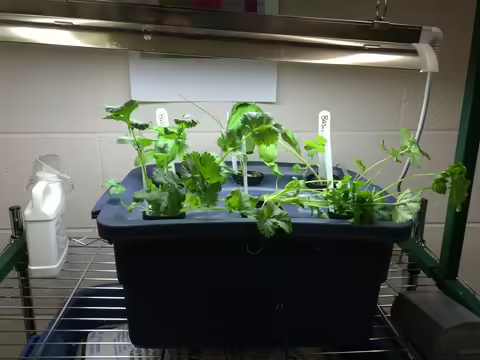DECATUR, Ill.— As the weather starts to remind us of the upcoming gardening season, it’s a great time to experiment with a do-it-yourself home hydroponics system. Most people have heard of hydroponics, but believe that using this method to grow plants is too difficult.
The use of hydroponics has been documented as far back as the first century when Roman Emperor Tiberius grew off-season cucumbers under what was described as transparent stone. Indoor hydroponics systems can be constructed with items such as a five-gallon bucket with lid, net pots, a growing medium, an air stone and an aquarium pump.
Studies have shown that plants grow up to 30% to 40% faster than a plant in soil, and there is a greater yield. Hydroponics allows plants to thrive in environments where there is no soil or the soil is contaminated, such as roof tops, abandoned buildings, vacated urban lands, etc. Weeding is not necessary, less water is used up to 10 times less and exposure to insects and other pests is decreased in indoor hydroponic systems.
There are two categories of home hydroponics systems. The passive hydroponic system relies on the capillary effect or what is sometimes referred to as wicking. The capillary effect helps bring nutrient rich fluid up into the roots. In a passive hydroponic system, the fluid is drawn up and absorbed by the growing medium.
An active hydroponic system relies on the nutrient solution to be delivered to the roots by a pump, and any excess solution simply drains away. A growing medium in not necessary in an active system.
“Hydroponic growing allows us to grow in locations or at times that would not be possible with the typical growing of plants outside in the soil,” said Doug Gucker, University of Illinois Extension Local Food Systems and Small Farms Educator. “In addition for the do-it-yourselfer, there are many plans for repurposing plastic buckets and other containers into easy to use hydroponic growing systems for the use indoors or outdoors on a balcony or porch.”
To find out how to build an indoor passive hydroponics system read this month’s Know How Know More blog post by Extension educator Doug Gucker.
University of Illinois Extension is the flagship outreach effort of the University of Illinois at Urbana-Champaign, offering educational programs to residents of all of Illinois’ 102 counties and far beyond. Extension provides practical education you can trust to help people, businesses, and communities solve problems, develop skills and build a better future. Extension offers educational programs in five broad areas: energy and environmental stewardship, food safety and security, economic development and
workforce preparedness, family health, financial security and wellness and youth development. Find us on Facebook or Twitter.
Source: Doug Gucker, University of Illinois Extension, Local Food Systems and Small Farms Educator serving DeWitt, Macon and Piatt Counties, (217) 877-6042 or ducker@illinois.edu. Doug is a Certified Crop Advisor and works to help producers improve their profitability and sustainability with programs and feedback
on farm management, soil health, nutrient management, integrated pest management and grazing.
News Writer: Maria Lightner, Marketing & Communications, Extension Program Coordinator
Contact
Doug Gucker
Extension Educator, Local Food Systems and Small Farms
Macon Extension Office
3351 N. President Howard Brown Blvd., Decatur, IL 62521
(217) 877-6042
